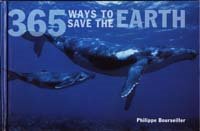Inspired Links

The Origin of 365 Ways...
I came across this amazing book by Phillippe Bourseiller when i was in Denmark close to a year ago:
"For the past 15 years, Phillippe Bourseiller has photographed nature from every angle: from the eruption of the volcano Pinatubo to the great deserts of ice and sand, he has captured the hidden colours and breathtaking lights of our planet.
But our contemporary way of life threatens this fragile beauty. To encourage more restraint, Philippe Bourseiller teams 365 photographs with a daily ecological action. Each of the initiatives is accompanied by facts and statistics that illustrate the threats to the environment posed by our behavious, and demonstrate the beneficial consequences of the recommended actions. Each day reveals the image of a wonder of nature along with the guidelines to preserve our planet. Through the pages of 365 Ways to Save the Earth, a truly ethical way of life takes shape."
Starting from today, i would like to post each inspiring page according to the days on the yearly calendar (supposed to start from jan, but...i'll catch up!). Hopefully, you'll look at everyday a little differently after this...
Blog Archive
-
▼
2007
(28)
-
▼
April
(18)
- Water - Trace leaks
- Biodiversity - Be unobtrusive while out in the cou...
- Agriculture - Choose a well-bred chicken
- Biodiversity - Refuse to buy any objects made from...
- Water - Do not waste water when travelling to plac...
- Gardening - Prevent Soil erosion
- Transport - Cycle or walk for short trips
- Agriculture - Buy organic food for your baby
- Waste - When you eat out, eat in
- Lifestyle - Lobby your MP about the environment - ...
- Chemicals - Wash your windows with vinegar
- Biodiversity - Leave protected plants and animals ...
- Agriculture - Buy traditional varieties of fruit a...
- Transport - Try an electric bike
- Chemicals - Use biodegradable cleaning products
- Lifestyle - Act now to preserve the environment. M...
- The origin of 365 Ways...
- Agriculture - Buy more Fair Trade products
-
▼
April
(18)
Friday, April 13, 2007
Water - Do not waste water when travelling to places where it is scarce
About 65 % of the water people use is pumped from underground aquifers. However, more is drawn off than is naturally replaced because impervious surfaces such as pavement and buildings prevent rainwater from entering the ground; therefore, aquifers are gradually being drained dry. Some aquifers close to the sea - in Spain, for example - have started to fill up with salt water. In India, the water table has dropped by between up to 3 metres over three-quarters of the country's area. This shortage is evidence of the need for proper conservation and management instead of technological fixes, such as desalinisation plants, to access more water.
_____________________________________________________________________
In some countries, water is scarce. Think about it when you are travelling. In developing countries, the average tourist uses as much water in 24 hours as a local villager does in 100 days. Be careful: take as few baths as possible and avoid wasting this precious liquid.
Subscribe to:
Post Comments (Atom)
About Me
- cnmmnc
- Who am i? What i say doesnt matter..What i have done? That makes me.

1 comment:
I love the fact that you used an image of the Namib in there. It certainly is true that tourists traveling to this area use way more water than the locals do!
Post a Comment